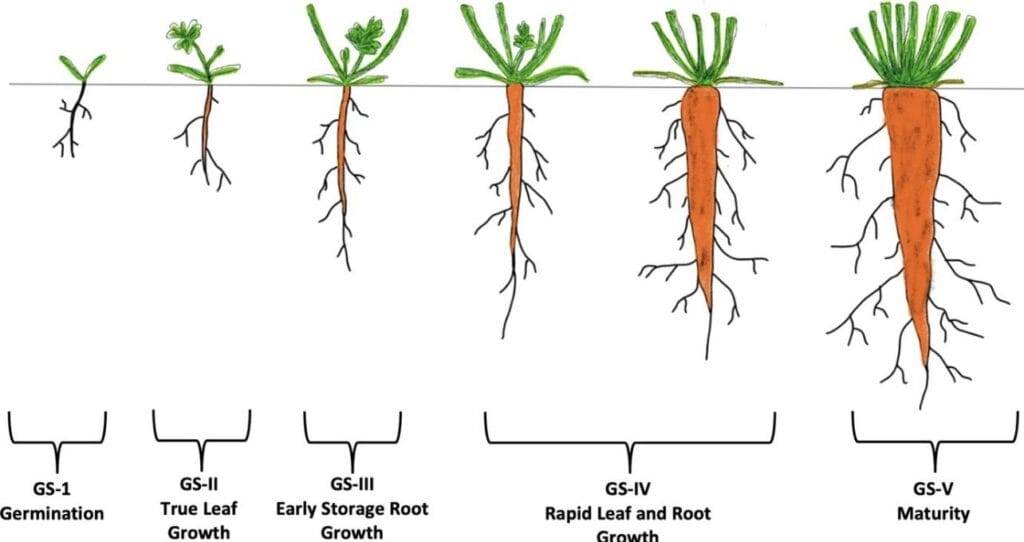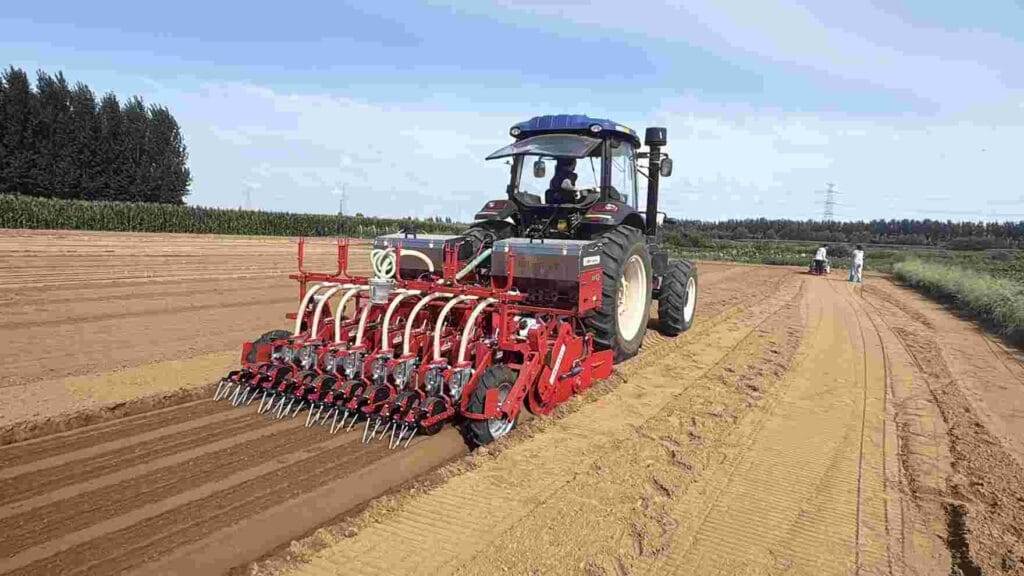Carrots are a common root vegetable with a large market demand and are widely cultivated. The seeds of carrots are small and have weak germination ability, requiring strict attention to the sowing depth. If sown too deep, seedling emergence becomes difficult; if sown too shallow, the seedlings are easily affected by wind and rain, leading to seedling death. Traditional manual point sowing or broadcast sowing methods struggle to ensure uniformity and consistency in depth, whereas modern air suction vegetable seeders provide precise guarantees for precision sowing. This article will systematically analyze the sowing depth of carrot seeds from the perspective of air suction seeders and extend to the practical application of seeders in carrot production.
1. Characteristics of carrot seeds and requirements for sowing depth
1. Biological characteristics of carrot seeds
Carrot seeds are small-sized seeds with a thousand-seed weight of only about 1–1.5 grams, and they have rough spines on their surface. Due to their small size and thin endosperm, the reserve nutrients are limited, and seedling emergence relies entirely on soil moisture conditions and sowing depth suitability. If sown too deeply, the seeds consume too much energy to “drill out” of the soil, often resulting in rotten seeds or weak seedlings.
2. Proper sowing depth
Generally speaking, the suitable sowing depth for carrot seeds is 0.5–1.5 centimeters.
• When the soil is loose and the moisture content is suitable, it can be controlled at 0.8–1 cm;
• In slightly dry plots, the depth can be slightly deeper, but should not exceed 1.5 centimeters;
• If sown too deeply in heavy soil, seeds may find it difficult to break through the soil layer.
Therefore, maintaining consistency within the shallow sowing range is crucial to ensure neat emergence of carrot seedlings.

II. Operating principle of air suction vegetable seeder
1. Principle of air suction precision seed metering
The air suction seeder primarily operates based on the vacuum negative pressure principle. The seed metering disc is equipped with tiny suction holes. The vacuum pump generates an airflow that attracts the seeds to the hole openings. As the seed metering disc rotates, the seeds are steadily carried to the seed metering slot. When passing through the seed unloading position, the negative pressure dissipates, causing the seeds to fall off and enter the trench created by the opener, achieving precise single-seed placement.
2. Advantages of adapting to small-sized seeds
Carrot seeds are small and irregular, and conventional mechanical seeding methods are prone to issues such as missed sowing and double sowing. However, air suction seeders can achieve stable adsorption and single-seed placement by adjusting the diameter of the suction hole and vacuum pressure, greatly improving the precision of seeding.
3. Seeding depth control system
Sowing depth control typically relies on the coordination between the depth adjustment of the opener and the depth limiting of the press wheel. The seeder ensures that each seed falls within the set depth range through its mechanical structure, without being affected by human error, thus achieving consistency in carrot sowing.

III. Key Factors in Controlling the Sowing Depth of Carrots
1. Soil details
Carrots are suitable for germinating in moist but non-compacted soil. If the soil is slightly dry, the sowing depth should be slightly increased to facilitate water absorption; if the soil moisture is high, shallow sowing is necessary to prevent oxygen deficiency.
2. Soil texture
• Sandy loam soil: suitable for shallow sowing (around 0.8 cm), conducive to seedling emergence.
• Loam: It can be maintained at around 1 cm.
• Clay: The sowing depth should not exceed 0.8 cm, otherwise the seedling emergence rate will decrease.
3. Seed quality and treatment
If the seeds have undergone pelleting or coating treatment, resulting in increased volume and weight, the sowing depth can be appropriately deepened to 1.2–1.5 cm. For ordinary bare seeds, the optimal sowing depth remains at 0.8–1 cm.
4. Parameter adjustment of air suction seeder
Seed depth control not only relies on the depth of the opener, but is also closely related to the pressure of the roller and the walking speed. When the walking speed is too fast, the seed landing point may deviate, resulting in uneven seed depth. Therefore, it is recommended to maintain a walking speed of 3–4 km/h for carrot sowing.

IV. How to ensure the appropriate planting depth of carrots with an air suction vegetable seeder
1. Design and adjustment of the trencher
Carrots are usually sown using a narrow opener, and the depth of the furrow can be precisely controlled within the range of 0.5–1.5 centimeters through a depth limiter. Some advanced models are also equipped with spring or hydraulic floating devices, allowing the furrow depth to be fine-tuned according to the terrain.
2. Stability of seed falling
The seeder releases seeds precisely through vacuum adsorption, ensuring that the landing point is consistent with the bottom of the ditch, thus avoiding uneven depth in manual sowing.
3. Backfilling and compaction system
Carrot seeds require fine soil coverage, with a thickness of approximately 0.3–0.5 cm. The soil covering device equipped on the air suction seeder can evenly cover the soil, and then the pressure roller gently presses down, ensuring close contact between the seeds and the soil while avoiding excessive soil coverage.
4. Multi-row consistency
A common issue with manual sowing is inconsistent depth between rows. However, air suction seeders can complete multi-row synchronous sowing in one operation, achieving extremely high consistency in depth and significantly improving seedling emergence uniformity.
V. Precautions in practical operation
1. Pre-sowing preparation
• The soil should be finely fragmented and leveled to avoid large clumps affecting the depth of sowing.
• It is best to carefully select the seeds, removing any that are too small or malformed, to facilitate adsorption.
• Equipment calibration: Conduct a trial broadcast on the field in advance to measure the actual broadcasting depth.
2. During the sowing process
• Adjust the depth of the trencher according to the soil moisture condition.
• Control the speed of the machinery and maintain uniform operation.
• Ensure the negative pressure of the vacuum pump is stable to avoid insufficient suction or excessive suction.
3. Post-sowing management
• If the weather is dry, timely sprinkling should be carried out to keep the soil moist and promote seedling emergence.
• Avoid heavy rain wash to prevent shallowly sown seeds from being exposed.
• After seedling emergence, thin the seedlings according to their condition to ensure reasonable plant spacing.
VI. Summary of the advantages of using air suction seeders to sow carrots
1. Precise sowing depth: Controlled within the range of 0.5–1.5 cm, suitable for carrot requirements.
2. Uniform seedling emergence: Consistent seed spacing and depth facilitate mechanical management in the later stages.
3. Labor-saving and efficient: Replacing manual seeding, it is fast and has low labor intensity.
4. Seed saving: Precision seeding can save 30–50% of seeds.
5. High adaptability: It can be flexibly adjusted according to different plots and seed conditions.
VII. Conclusion
Carrot seeds are small and fragile, and they have strict requirements for sowing depth, with the optimal sowing depth being 0.8–1 cm and a maximum of no more than 1.5 cm. The air suction carrot seeder, through its precise negative pressure adsorption seeding system, stable ditching and soil covering device, and accurate depth limiting mechanism, can effectively ensure the consistency and accuracy of sowing depth. Combined with reasonable adjustments to soil moisture content, seed treatment, and operating speed, it can significantly improve the emergence rate and uniformity of carrot seedlings, thereby enhancing yield and quality.
With the development of agricultural mechanization, air suction seeding technology has become the core equipment for efficient cultivation of small-seed crops such as carrots. In the future, it will become more intelligent and precise, providing strong support for large-scale production.

